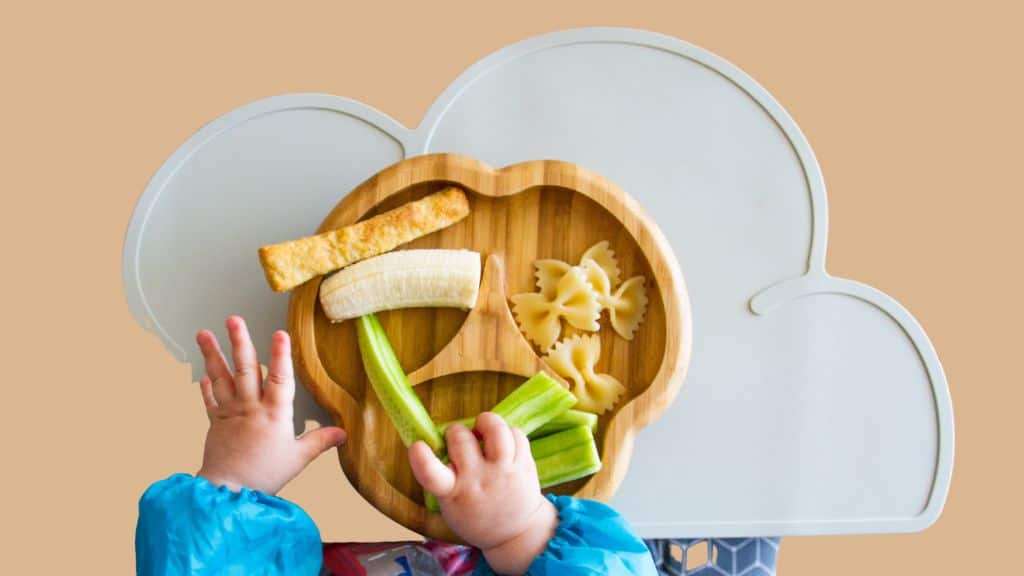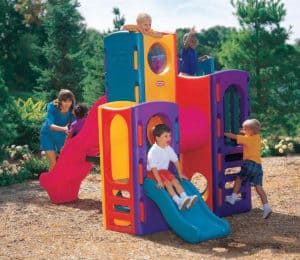
Table of Contents
Baby-led weaning is a method popularized by Tracey Murkett and Gill Rapley in the U.K. with their publication “Baby-led Weaning”. Since then it has become a popular method to wean young babies and its enthusiasm knows no bounds in the world. It has become popular among young parents with its family-friendly and natural food options to wean a baby.
We Have brought to you foods and success tips with a bit of do’s and don’ts of baby-led weaning to get you started. Read on to find out about the benefits of baby-led weaning and more!
First Things First, What is Baby-led Weaning?
Baby-led weaning is an eating practice for young babies where 6-month-olds jump straight to finger foods bypassing mashed-up foods and purees. This approach is exactly what the term suggests: allowing your baby to feed themselves with healthy foods.
This method allows the baby to learn how to chew and swallow. It also saves young parents from pushing the food as babies are in charge of how much they put in their mouths. These are not the only benefits of baby-led weaning.
According to research, potential perks of this method include:
Babies Become Familiar With a Variety of Flavors and Textures at a Young Age
In the long run, this helps them to develop healthy and varied food preferences and they will be less fussy when it comes to healthy foods. Several studies show that babies who have been introduced to healthy food options at a young age are less likely to develop food allergies later in life (such as peanut products). Remember that seafood and nuts are common food allergens among children so ask your pediatrician about how to introduce them to your baby.
They Have a Reduced Risk of Child Obesity
A spoon-fed baby is in the control of the parent which may make the babies eat faster and more than they need. This may lead to a habit of ignoring feelings of fullness. Similar to breastfeeding, baby-led weaning teaches the baby to self-regulate on how much they eat. This results in a lower chance of the baby becoming obese or overweight when compared to spoon-fed children.
The Method Promotes Fine Motor Skill Development
If you stick with finger foods for most of the baby-led weaning process, your baby will develop excellent hand-eye coordination and manual dexterity. Introducing baby-led weaning at 6 months is the perfect way to instill these motor skills in them in the long run.
Benefits of Baby-led Weaning
In a nutshell, baby-led weaning indicates skipping spoon-fed purees and letting the baby feed. Choose finger foods when you begin baby-led weaning (at the prime age of 6 months). For starters, this method will help in fine-tuning motor development along with:
- Healthy eating habits
- Dexterity
- Chewing skills
- Hand-eye coordination
- Taste exploration
- New textures
- Sense of smell (aroma)
- Color introduction
Also, babies who self-feed won’t eat more than what their hunger demands since they are independently feeding themselves. Parents may sneak a couple of more spoonfuls but that’s about it. We would advise you to not do that frequently because it will teach the baby to eat more than what is routine.
It’s important to note that baby-led weaning might not benefit all babies. Babies who have neurological issues and/or developmental delays should start on solid foods traditionally. Also, you need to be vigilant about food allergies and choking hazards (read on a little bit more to know what you should do if your baby chokes).
When to Start Baby-led Weaning?
When to start on your baby-led weaning recipes depends on when your baby is ready. They should be old enough to sit on a high chair with no assistance, be able to move food to the back of their mouth, have good neck strength, and be able to move their jaws up and down.
Most children above 6 months of age have developed enough to self-feed. However, they might not develop strong chewing skills until they are about 9 months of age. Baby-led weaning will help them acquire those skills. Also, the term “weaning” is a kind of a misnomer because there are plenty of other ways (apart from ginger foods) to wean your baby.
Baby-led Weaning Foods: What to Give Your Weaning Baby?
Do not get misled by babies chewing on improbable foods (from casseroles to drumsticks) on ad pages of infants. Most expert recommendations suggest beginning the baby-led weaning process slowly by starting with single-ingredient foods. This way you can pinpoint any potential allergies. Examples of first finger foods include:
- Strips of chicken
- Strips or pieces of omelet
- Pasta
- Poaches and flaked salmon
- Moist and shredded meats
- Baked sliced apples with no peels
- Steamed broccoli florets
- Avocado
- Bananas
Substantial-sized pieces of food are the easiest for your baby to pick up. Cut your food into thin, long strips with a crinkle-cutter or even in a coin shape to make the food manageable for the baby. Very few 6 to 8-month-olds have mastered the pincer grasp (grasping with the index and thumb finger), so they will likely pick up the food with their whole palm. Once your baby has learned the pincer grasp (that’ll be around their 8th or 9th month), you can serve small pieces of food like:
- Pieces of pasta
- Chopped steamed spinach
- Cooked beans
- Ripe mango chunks
Another key to baby-led weaning is texture. The food you give your baby should be soft enough to smash with gentle pressure (try mashing it in between your forefinger and thumb). For instance, you should serve your baby with steamed vegetables and fruits when you are beginning the baby-led weaning process.
Let your munchkin get used to several single-ingredient foods before you start mixing the dishes. Ensure that the foods you serve them are high in:
- Calories
- Healthy fats
- Proteins
- Zinc
- Iron
Cook with less or no salt as a baby’s body cannot process sodium effectively.
What if The Baby Chokes?
Even though most babies are adept at eating finger foods, gagging is a common thing in their early days of eating. It is a reflexive safety mechanism of the body that might cause sputtering, coughing, or watery eyes. Parents need to keep in mind that gagging is a safe reflex of the body to get rid of the food that is too challenging for the baby’s system to process. Babies react to their parents or caregivers’ reactions so do not freak out when you see them gagging because they will get scared too.
Choking is an entirely different thing from gagging. It happens when the food is stuck in the windpipe or throat and blocks the flow of air. If your baby is choking, they probably won’t make any sound or move air effectively. Take a good look at your baby’s symptoms to make sure if they are gagging or choking.
To avoid choking you can stay clear of choking food hazards such as:
- Sticky nut butter
- Raw vegetables
- Popcorn
- Raisins
- Hot dogs
- Grapes, etc.
Get yourself familiarized with infant-specific Heimlich maneuver and as a precaution stay near your baby when they are self-feeding. Also, do not feed them while lying down, make them sit up so nothing gets stuck in their throat. To be safe, follow these rules:
- ALWAYS stay near your baby when they are eating
- ALWAYS make them sit up when they eat
- Serve foods that are soft enough to smash (raw apples are one of the biggest choking hazards for baby-led weaning children)
- To be prepared, take an infant-first-aid class
- If your baby is gagging do not show panic which can be sensed by the baby. They tend to develop negative associations with eating if they sense your panic. Try to calmly give them time to work it out.
IMPORTANT: We strongly urge all parents to take an infant CPR class to be on the safe side.
Baby-led Weaning Success Tips
Make a Mixed Approach
If spoonfeeding is the most comfortable approach for your baby then no need to abandon it completely when you introduce finger foods. For the first month or two of baby-led weaning, your little one will do a lot of exploring, tasting, and licking but not much of actual eating. So when you puree your food, make it more nutritious and filling.
Some babies are just not ready for finger foods at 6 months of age and if your baby is one of them you can go for a mixed approach. This will expose them to finger foods easily with the transition not being abrupt. Later on, you can make purees with a lumpy texture to develop your baby’s chewing skills.
Prepare for a Messy Day
When babies explore food at their own pace (as is the goal of baby-led weaning), there will be a messy table for you to clean after. There is bound to be a lot of dropping, smearing, and smashing of food at nearly every meal. However, did you know that a messy food table means an essential milestone in learning?
Your floor will likely see the first of it so you could keep a plastic tablecloth that is easy to clean or a garbage bag under the high chair. You can also balance messy foods with dry foods like toast or cereal and replace your baby’s bib with an art smock.
Dine Together
Allowing the baby to eat with the family is their way to learn to eat food like the others, achieving an essential learning milestone. You could also give them some of the same ingredients you are having.
Use Baby-safe Utensils
Let your baby reach for the spoon and guide it to their mouth themselves without your help. It’s not that you shouldn’t help but let them be as independent as possible. It is key to encourage your child to deliver food early on but ensure that the child is always leading the process. Also, avoid skewers or toothpicks (injury alert!)
Ensure Enough Nutrients
At 6 months, your baby is still getting its major part of nutrition from formulas or breastmilk. So do not worry if they don’t swallow solid foods. They might seem unsatisfied or frustrated with their meals and that is when you can introduce finger foods with purees. You may continue doing so until they get the hang of self-feeding.
Do Not Get Over Emotional or Heated
The key is to not get emotional or heated when you are spoon-feeding your baby or if they are self-feeding. Eating should be treated as an expected routine of the day. Don’t scold, pressure, or praise about eating
The Bottom Line: Baby-led Weaning Foods
Baby-led weaning method is the most effective process of introducing new food varieties to your little one at the age of 6 months and weaning your child later on. It helps in developing:
- Motor skills
- A palate for healthy foods
- Healthy food choices later in life
- Early weaning, etc.
Baby-led weaning involves giving your child finger foods even before purrs or spoon feeding. If you are already spoon-feeding you can combine the three methods because a sudden transition might not go down well with the baby. One of the best foods for baby-led weaning is bananas along with sweet potatoes, hard-boiled eggs, etc. You could gather more information about this weaning method from several baby-led weaning books written by experienced mothers instead of just depending on online searches.
Remember: Breastmilk or formula is the primary and priority source of nutrition for the first year of life.
Baby-led Weaning FAQs:
1. When to start baby-led weaning?
2. How to start baby-led weaning?
3. What should a baby-led weaning breakfast contain?
4. What are some first foods for baby-led weaning?
5. Is baby-led weaning recommended?
Reviewed By:

Leslie Owens - RN IBCLC, Lactation Coach & Consultant
Leslie Owens is a Perinatal RN and IBCLC based in the Atlanta area. She prides herself as a human milk advocate, facilitator, and clinician. She has supported pregnant and postpartum families for over 10 years in the perinatal space. Her passion for birth and lactation began with her own personal experiences, birthing and breastfeeding three children, including twins.
Leslie currently owns and operates Mother Nurture Maternity, a private practice where she provides breastfeeding education and support, as well as coaching and mentorship to aspiring and new IBCLCs, She is committed to providing accessible, skilled, compassionate, and equitable care to all.









